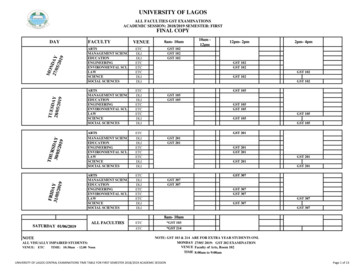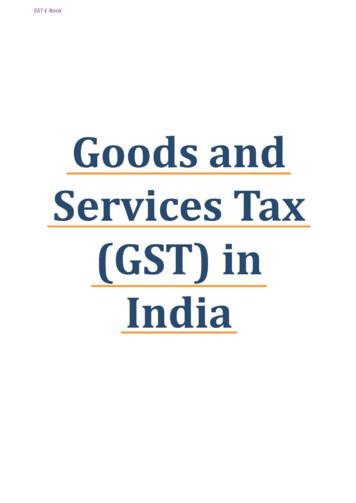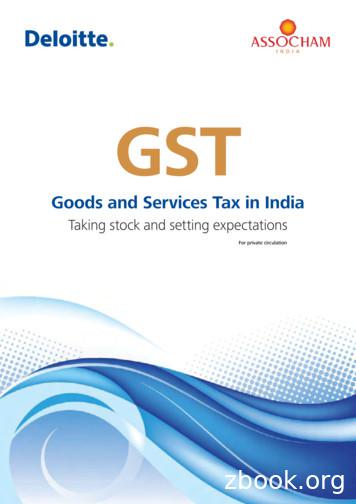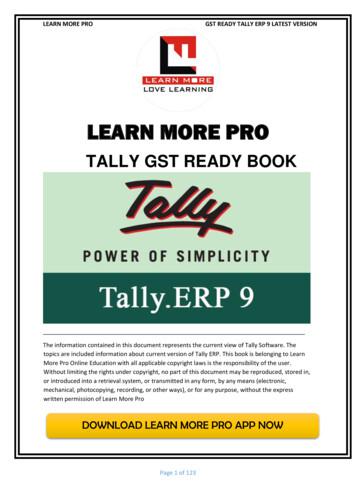Course Information Course Code: GST 204 Course Team
Course InformationCourse Code:GST 204Course Title:Credit Unit:Course Status:Semester:Required Study Hour:EditionEntrepreneurship and Innovation2Compulsory2nd4 hours per weekFirstCourse TeamCourse Developer:Course Writer:Instructional Designer:Learning Technologists:Content Editor:Copy Editors:Prof. May Ifeoma Nwoye Ph.D.Prof. May Ifeoma Nwoye Ph.D.Inegbedion, Juliet O. (Ph.D.)Dr. Adewale Adesina, Nura Maidoki, & Henry UdeProf. Abdul Salam JibrilInegbedion, Juliet O. (Ph.D.) & Christiana Uzoukwu(Mrs)Ice BreakerUpload your passport and introduce yourself by stating your names, what you dofor a living, your hobby, your expectation in this course and the name you wouldprefer to be called during this course.NATIONAL OPEN UNIVERSITY OF NIGERIA
2018 by NOUN PressNational Open University of NigeriaHeadquartersUniversity VillagePlot 91, Cadastral ZoneNnamdi Azikiwe ExpresswayJabi, AbujaLagos Office14/16 Ahmadu Bello WayVictoria Island, Lagose-mail: centralinfo@nou.edu.ngURL: www.nou.edu.ngAll rights reserved. No part of this book may be reproduced, in anyform or by any means, without permission in writing from the publisher.Published by:National Open University of NigeriaHeadquarters, University VillagePlot 91, Cadastral Zone, Nnamdi Azikiwe ExpresswayJabi, Abuja, NigeriaPrinted by NOUN Pressnp@noun.edu.ngPrinted 2018ISBN: 978-978-8521-93-82
Course GuideIntroductionWelcome to GST 204: Entrepreneurship and Innovation. GST 204 is a twocredit unit course that has minimum duration of one semester. It is a compulsorycourse for all undergraduate students in the university. This course is anintroductory course for studying Entrepreneurship for the first time. The designand flow of the course are aimed at creating awareness, providing the knowledgeand skills that are important to achieving success in all human endeavours.Course ObjectivesThe objective of this course is to:1. Provide a hands-on, practical guidance to understand and discover criticalaspects of Entrepreneurship;2. Develop competencies, know-how, experience, attitudes, resources, andnetwork required to pursue different Entrepreneurial opportunities;3. Introduce you to the key requirements for starting an enterprise; and4. Expose you to many of the vital issues and immerse you in key learningexperiences, such as the theories of Entrepreneurship, the Nigerianbusiness environment, and the concept and management of innovation.Working through this CourseTo successfully complete this course, read the study units, listen to the audiosand videos, do all assessments, open the links and read, participate indiscussion forums, read the recommended books and other materials provided,prepare your portfolios, and participate in the online facilitation.Each study unit has introduction, intended learning outcomes, the main content,conclusion, summary and references/further readings. The introduction will tellyou the expectations in the study unit. Read and note the intended learningoutcomes (ILOs). The intended learning outcomes tell you what you should beable to do at the completion of each study unit. So, you can evaluate yourlearning at the end of each unit to ensure you have achieved the intendedlearning outcomes. To meet the intended learning outcomes, knowledge ispresented in texts, video and links arranged into modules and units. Click on thelinks as may be directed but where you are reading the text off line, you will haveto copy and paste the link address into a browser. You can download the audiosand videos to view off line. You can also print or download the texts and save inyour computer or external drive. The conclusion gives you the theme of theknowledge you are taking away from the unit. Unit summaries are presented indownloadable audios and videos.3
There are two main forms of assessments – the formative and the summative.The formative assessments will help you monitor your learning. This ispresented as in-text questions, discussion forums and Self-AssessmentExercises.The summative assessments would be used by the university to evaluate youracademic performance. This will be given as Computer Based Assessment(CBA) which serves as continuous assessment and final examinations. Aminimum of three computer based test will be given with only one finalexamination at the end of the semester. You are required to take all thecomputer based tests and the final examination.Study UnitsThere are 37 study units in this course divided into nine modules. The modulesand units are presented as follows:Module 1Unit 1Unit 2Unit 3Unit 4Unit 5Development Entrepreneurship/IntrapreneurshipAn Overview of the Definitions of Entrepreneurship andIntrapreneurshipConcepts and Theories of EntrepreneurshipThe Entrepreneurship CultureBrief Biographical Studies of Prominent Nigerian EntrepreneursBarrier to Entrepreneurial PracticeModule 2Unit 1Unit 2Unit 3Unit 4The Nigerian Entrepreneurial EnvironmentThe Business External EnvironmentIdentifying Business Opportunities and ThreatsStrategies for exploring opportunities in the EnvironmentApproaches to addressing environmental barriersModule 3Unit 1Unit 2Unit 3Creativity and Intellectual RightsIntellectual Properties and its DimensionsCopyright Laws in NigeriaStrategies for Protection of Intellectual Property (Original Ideas,Concepts, Products, etc.)Module 4Unit 1Technological EntrepreneurshipThe Interface between Technology Development andEntrepreneurshipTechnological Environment and BusinessNew Technology and Entrepreneurship OpportunitiesUnit 2Unit 34
Module 5Unit 1Unit 2Unit 3Unit 4Unit 5Management and InnovationThe Concept, Nature and Types of InnovationInnovation Theory of EntrepreneurshipFinancing Innovation and New VenturesChange ManagementTechnical Change and Management of InnovationModule 6Unit 1Unit 2Unit 3Unit 4Family Business and Succession PlanningThe Concept of Family Business ContentsThe Cultural Contexts of Family BusinessRoles and Relationship in Family BusinessOwnership Transfer and Succession in Family BusinessModule 7Unit 1Unit 2Unit 3Women EntrepreneurshipThe Concept of Women EntrepreneurshipRole orientation and Women Entrepreneurial AspirationsContributions of Women to National Socio-Economic and HumanDevelopmentBarriers to Women Entrepreneurial PracticeUnit 4Module 8Unit 1Unit 2Unit 3Unit 4Unit 5Social EntrepreneurshipThe Concept of Social EntrepreneurshipSocial Entrepreneurship and Value CreationThe Roles of Non-governmental Organizations in SocialEntrepreneurshipSocial Entrepreneurship and Funding OpportunitiesSocial Entrepreneurship Enhancement FactorsModule 9Unit 1Unit 2Unit 3Unit 4Business Opportunity EvaluationSources of Business Opportunities in NigeriaThe Difference between Ideas and OpportunitiesScanning Business Opportunities in NigeriaEnvironment and New Venture Idea GenerationReferences and Further ReadingsBusinessDictionary.Com (2010). ry.com/ definition/entrepreneurship.html.Burnett, David (2000). “Hunting for Heffalumps: The Supply ofEntrepreneurship and Economic Development”.http://www.technopreneurial.com/ articles/history.asp.Cantillon, R. (circa 1730). In Putari, Vijith (2006). “Re: Evolution ofEntrepreneurship”.5
s, D & Freel, M. (2009). Entrepreneurship and Small Firms. in Wikipedia(2010). “Entrepreneur”. Wikipedia, the freeencyclopedia.http://en.wikipedia.org/ wiki/Entrepreneur#cite ref-0.Di-Masi, Paul (2010). “Defining definemicro.html.Gartner (1988) in Putari, Vijith (2006). ―Re: Evolution of om forums/entrepreneurship/1118Evolution entrepreneurship.html.Bathia, .D. (2013). Theories of entrepreneurship. Retrieved fromhttp://slideshare/theoriesof entrepreneurship.htmlYnkamat, O. (2009). Theories of entrepreneurship. http://scrib.com/theories ofentrepreneurshipAfricansuccess.org. (2008). “Biographical Data: Aliko Dangote”.http://www.africansuccess.org /visuFiche.php?id 469&lang en.Africansuccess.org. (2010). “Biographical data: Mike Adenuga”.http://www.africansuccess. org/visuFiche.php?id 793&lang en.African Venture (2003). ervices.htm.Bizcovering.com (2010). “The History of Entrepreneurship in Nigeria”.http://bizcovering. com/ #ixzz0yDNj4Pxl.Presentation ScheduleThe presentation schedule gives you the important dates for the completion ofyour computer-based tests, participation in forum discussions and participation atfacilitation. Remember, you are to submit all your assignments at the appropriatetime. You should guide against delays and plagiarisms in your work. Plagiarismsis a criminal offence in academics and is highly penalized.AssessmentThere are two main forms of assessments in this course that will be scored: theContinuous Assessments and the final examination. The continuous assessmentshall be in three-fold. There will be two Computer Based Assessment. Thecomputer-based assessments will be given in accordance to university6
academic calendar. The timing must be strictly adhered to. The ComputerBased Assessments shall be scored a maximum of 10% each, while yourparticipation in discussion forums and your portfolio presentation shall be scoredmaximum of 10% if you meet 75% participation. Therefore, the maximum scorefor continuous assessment shall be 30% which shall form part of the final grade.The final examination for GST204 will be maximum of two hours and it takes 70percent of the total course grade. The examination will consist of 70 multiplechoice questions that reflect cognitive reasoning.Note: You will earn 10% score if you meet a minimum of 75% participation in thecourse forum discussions and in your portfolios otherwise you will lose the 10%in your total score. You will be required to upload your portfolio using GoogleDoc. What are you expected to do in your portfolio? Your portfolio should benote or jottings you made on each study unit and activities. This will include thetime you spent on each unit or activity.How to get the Most from the CourseTo get the most in this course, you need to have a personal laptop and internetfacility. This will give you adequate opportunity to learn anywhere you are in theworld. Use the Intended Learning Outcomes (ILOs) to guide your self-study inthe course. At the end of every unit, examine yourself with the ILOs and see ifyou have achieved what you need to achieve.Carefully work through each unit and make your notes. Join the online real timefacilitation as scheduled. Where you missed the scheduled online real timefacilitation, go through the recorded facilitation session at your own free time.Each real time facilitation session will be video recorded and posted on theplatform.In addition to the real time facilitation, watch the video and audio recordedsummary in each unit. The video/audio summaries are directed to salient part ineach unit. You can assess the audio and videos by clicking on the links in thetext or through the course page.Work through all self-assessment exercises. Finally, obey the rules in the class.FacilitationYou will receive online facilitation. The facilitation is learner centred. The modeof facilitation shall be asynchronous and synchronous. For the asynchronousfacilitation, your facilitator will: Present the theme for the week; Direct and summarise forum discussions;7
Coordinate activities in the platform;Score and grade activities when need be;Upload scores into the university recommended platform;Support you to learn. In this regard personal mails may be sent.Send you videos and audio lectures; and podcastFor the synchronous: There will be eight hours of online real time contact in the course. Thiswill be through video conferencing in the Learning Management System.The eight hours shall be of one-hour contact for eight times. At the end of each one-hour video conferencing, the video will beuploaded for view at your pace. The facilitator will concentrate on main themes that are must know in thecourse. The facilitator is to present the online real time video facilitation time tableat the beginning of the course. The facilitator will take you through the course guide in the first lecture atthe start date of facilitationDo not hesitate to contact your facilitator. Contact your facilitator if you: do not understand any part of the study units or the assignment.have difficulty with the self-assessment exerciseshave a question or problem with an assignment or with your tutor’scomments on an assignment.Also, use the contact provided for technical support.Read all the comments and notes of your facilitator especially on yourassignments, participate in the forums and discussions. This gives youopportunity to socialise with others in the programme. You can raise any problemencountered during your study. To gain the maximum benefit from coursefacilitation, prepare a list of questions before the discussion session. You willlearn a lot from participating actively in the discussions.Finally, respond to the questionnaire. This will help the university to know yourareas of challenges and how to improve on them for the review of the coursematerials and lectures.8
CONTENTSModule 1Unit 111Unit 5Development Entrepreneurship/IntrapreneurshipAn Overview of the Definitions of Entrepreneurship andIntrapreneurshipConcepts and Theories of EntrepreneurshipThe Entrepreneurship CultureBrief Biographical Studies of Prominent NigerianEntrepreneursBarrier to Entrepreneurial PracticeModule 2Unit 1Unit 2Unit 3Unit 4The Nigerian Entrepreneurial EnvironmentThe Business External EnvironmentIdentifying Business Opportunities and ThreatsStrategies for Exploring Opportunities in the EnvironmentApproaches to Addressing Environmental Barriers6363707478Module 3Unit 1Unit 2Unit 3Creativity and Intellectual Righ
np@noun.edu.ng Printed 2018 ISBN: 978-978-8521-93-8 . 3 Course Guide Introduction Welcome to GST 204: Entrepreneurship and Innovation. GST 204 is a two-credit unit course that has minimum duration of one semester. It is a compulsory course for all undergraduate students in the university. This course is an
gst 201 8am- 10am gst 102 gst 102 gst 102 gst 105 gst 105 gst 105 12pm- 2pm gst 102 gst 102 gst 102 gst 105 gst 105 gst 105 y 9 arts management sciences education engineering environmental sci. law law science social sciences arts day faculty science social sciences arts management sciences
Budgeted balance sheet This budget is prepared using the asset, liability and owner’s equity accounts. If GST payable (on GST collected) is GST input tax credits (on GST paid), the net GST payable is shown as a current liability. If GST payable (on GST collected) is GST input tax credits (on GST paid), the net GST input tax
3. Implementation of GST And Acts of GST 4. Whom to Register under GST 5. Who is Exempted from Register under GST 6. GST Composition Scheme 7. Invoice and Its Format under GST 8. Bill of Supply and Its Format under GST 9. E – Way Bill under GST 10. Time of Supply under GST 11. Place of Supply of Goods
GST For Jewellers Frequently Asked Questions . 2 1. What is GST? Ans- GST is an indirect tax which will eliminate various taxes like VAT tax, Excise, Service tax, Octroi, etc. 2. From when will be GST implemented? Ans- GST is likely to be implemented from 1st July 2017. 3. Is income tax required to be paid after GST? .
GsT – COmpleTInG yOur ACTIvITy sTATemenT 5 01 TermS We uSe When we say: n sales, we are referring to the GST term supplies n purchases, we are referring to the GST term acquisitions n GST credits, we are referring to the GST term input tax credits n reporting period, we are referring to the GST term tax period
(Malaysia) BL 6 % Purchases with GST incurred but not claimable (Disallowance of Input Tax) (e.g. medical expenses for staff). GST Goods And Services Tax (Malaysia) NR 0% Purchase from non GST-registered supplier with no GST incurred. GST Goods And Services Tax (Malaysia) ZP 0% Purchase from GST-registered
Contents Global Value Added Tax (VAT)/ Goods and Service Tax (GST) Trends 2 Proposed GST Structure for India 6 Key Concepts under Proposed GST structure for India 11 Role of Goods and Services Tax Network (GSTN) 17 Summary of expectations from proposed GST regime in India 20 About Deloitte 23 About ASSOCHAM 24 Goods and Services Tax (GST) in India Taking stock and setting expectations 1
Advantages and Disadvantages . (in GST) Activation of GST in Tally GST Purchase Invoice Creating GST Sales Invoice GST Tax Ledgers GST Invoices of Trading Organization Printing Invoice in Tally . discounting, stock valuation methodology, etc. Tally accounting software also comes wit























